Episode #304 - Plants & Flowers for a Healthy Home
Episode #304- Plants & Flowers for a Healthy Home
Today on Life In Bloom, plants, blooming and otherwise, are the focus. We’ll look at ways plants can improve the health of your home, we’ll include a plant in a beautiful bouquet, and experience a bit of Monstera madness.
“I grow plants for many reasons: to please my eye or to please my soul, to challenge the elements or to challenge my patience, for novelty or for nostalgia, but mostly for the joy in seeing them grow.” — David Hobson
 Plants in the home are enjoying popularity at levels not experienced since the 1970’s! Have you added plants to your home recently?I know the plant population in my home is on the rise. Blooming or not, I can’t seem to resist adding more plants to the collection over the past couple of years, especially the Monstera variety. I may have been known to nick a piece of foliage or two for my flower arrangements. Plants do come in handy when unexpected arrangements are required - especially when the garden is out of season. Let’s take a closer look at these home companions and the contributions they make towards bettering our lives, today on Life In Bloom.
Plants in the home are enjoying popularity at levels not experienced since the 1970’s! Have you added plants to your home recently?I know the plant population in my home is on the rise. Blooming or not, I can’t seem to resist adding more plants to the collection over the past couple of years, especially the Monstera variety. I may have been known to nick a piece of foliage or two for my flower arrangements. Plants do come in handy when unexpected arrangements are required - especially when the garden is out of season. Let’s take a closer look at these home companions and the contributions they make towards bettering our lives, today on Life In Bloom. Plants for a Healthy HomeWhile I enjoy the company (and greenery) of living with indoor plants, did you know those plants can also help improve your health just by being in your home?”A 1989 NASA experiment found that certain indoor plants can improve the air quality in a home by absorbing chemicals like benzene and formaldehyde from the air. The research found that a number of different houseplants could act as natural air filters.
Plants for a Healthy HomeWhile I enjoy the company (and greenery) of living with indoor plants, did you know those plants can also help improve your health just by being in your home?”A 1989 NASA experiment found that certain indoor plants can improve the air quality in a home by absorbing chemicals like benzene and formaldehyde from the air. The research found that a number of different houseplants could act as natural air filters.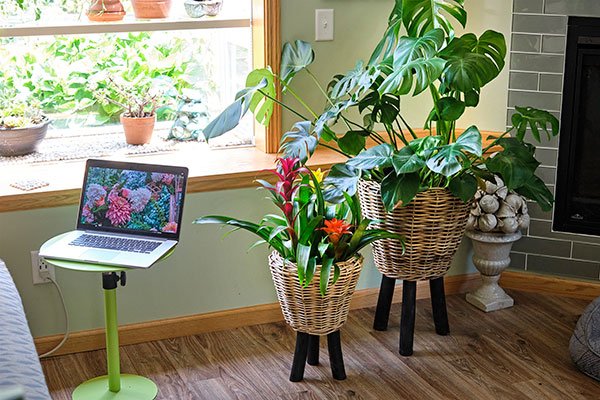 Why Plants instead of Air FiltersWhy would NASA study house plants instead of just going with the high tech solution for space travel: air purifying equipment? For one thing, air purifiers require maintenance. This means parts for when they break down along with periodic filter replacement. And, dirty filters mean garbage which can be a complicated problem to solve in space. In addition, air filters only purify the air. They don’t create oxygen like plants do. Sometimes you just can’t replace what Mother Nature can do – even in outer space!Back here on earth, air purifiers work fine for ensuring clean, safe air to breath in the home or at the office. From a practical perspective, however, plants are a much cheaper and feng shui approach, wouldn’t you agree?Additionally, a study has shown that being in an environment with plants can help reduce stress and improve blood pressure and heart rate.Here's a Link for more research involving plants and our health!https://www.onegreenplanet.org/natural-health/10-plants-that-improve-the-air-quality-in-your-home/
Why Plants instead of Air FiltersWhy would NASA study house plants instead of just going with the high tech solution for space travel: air purifying equipment? For one thing, air purifiers require maintenance. This means parts for when they break down along with periodic filter replacement. And, dirty filters mean garbage which can be a complicated problem to solve in space. In addition, air filters only purify the air. They don’t create oxygen like plants do. Sometimes you just can’t replace what Mother Nature can do – even in outer space!Back here on earth, air purifiers work fine for ensuring clean, safe air to breath in the home or at the office. From a practical perspective, however, plants are a much cheaper and feng shui approach, wouldn’t you agree?Additionally, a study has shown that being in an environment with plants can help reduce stress and improve blood pressure and heart rate.Here's a Link for more research involving plants and our health!https://www.onegreenplanet.org/natural-health/10-plants-that-improve-the-air-quality-in-your-home/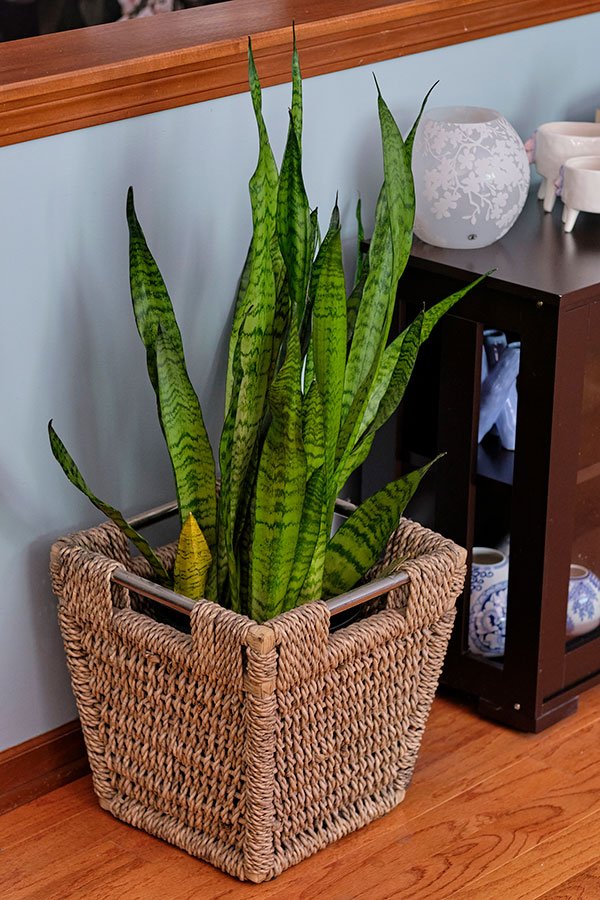 10 Best PlantsSo the question is often asked- "How many plants are appropriate (and helpful) for your home?" -The conventional wisdom is 1 Plant per 100 Square feet - or several for a large living area... this will surely improve your health and wellness- and also give you something to care for... this caring action- is also beneficial- as the plants truly "love and thrive" on our attention too!It’s Important to have Plants potted in soil- plants without soil don’t do the job as well... this refers to plants like air ferns- or cuttings of plants that are growing in water... so remember - the dirt actually adds additional benefits!Here's a link to more information and helpful ideas!
10 Best PlantsSo the question is often asked- "How many plants are appropriate (and helpful) for your home?" -The conventional wisdom is 1 Plant per 100 Square feet - or several for a large living area... this will surely improve your health and wellness- and also give you something to care for... this caring action- is also beneficial- as the plants truly "love and thrive" on our attention too!It’s Important to have Plants potted in soil- plants without soil don’t do the job as well... this refers to plants like air ferns- or cuttings of plants that are growing in water... so remember - the dirt actually adds additional benefits!Here's a link to more information and helpful ideas!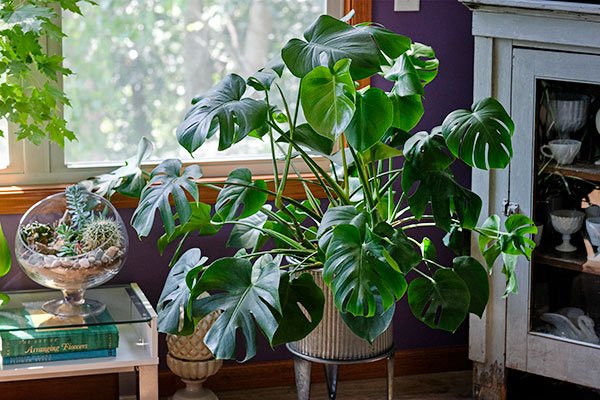 In my home- I have the many of the plants listed in this research- a couple peace lilies, The Snake Plant (aka Sansivaria), Corn Plants of several different sizes, Variegated Pothos, and of course several of ONE of my All Time Favorites- The Monstera!I have deliberately placed a Monstera, Corn Plant, and Sansaveria in the bedroom to help improve my sleep- these plants are noted for their helpfulness during sleep- and the exchange of CO2 for Oxygen- is helpful no matter where they live in the house!Here's a few other helpful Plant Article Resourceshttps://www.thehealthyhomeeconomist.com/house-plants-for-clean-indoor-air/https://www.huffpost.com/entry/best-houseplants-destress_n_2964013https://www.healthline.com/health/healthy-home-guide/benefits-of-indoor-plantsHere's a quick House Plant Health and Wellness Summary from the articles and resources above:
In my home- I have the many of the plants listed in this research- a couple peace lilies, The Snake Plant (aka Sansivaria), Corn Plants of several different sizes, Variegated Pothos, and of course several of ONE of my All Time Favorites- The Monstera!I have deliberately placed a Monstera, Corn Plant, and Sansaveria in the bedroom to help improve my sleep- these plants are noted for their helpfulness during sleep- and the exchange of CO2 for Oxygen- is helpful no matter where they live in the house!Here's a few other helpful Plant Article Resourceshttps://www.thehealthyhomeeconomist.com/house-plants-for-clean-indoor-air/https://www.huffpost.com/entry/best-houseplants-destress_n_2964013https://www.healthline.com/health/healthy-home-guide/benefits-of-indoor-plantsHere's a quick House Plant Health and Wellness Summary from the articles and resources above:
- House Plants Clear Toxins from the air- through transpiration and exchange of CO2 to Oxygen
- It's a Proven Fact- You Feel Less Sick- when Plants are around!
- Plants Boost Your Mood - through Horticulture Therapy
- Research Proved- that those surrounded by Living Plants Think Better and Smarter
- The Research also provided that Pictures of Trees or Plants- provided similar effects!
- Be careful of your own personal allergies and the safety of your pets when choosing Plants for your home!
In this episode of Life in Bloom- I Discuss Plants as a decorative element - Having Plant images or representation of plants on pillows, shirts, curtains, glassware, artwork, etc. provides similar health and wellness benefits to the actual plant... So just looking at pictures of plants or their image- benefits our health and wellness! Featured Foliage: Monstera- Monstera Deliciosa is also known as the Swiss Cheese Plant, so named for holes that develop in the leaves- The holes in the leaves better withstand heavy rainfall and wind as the elements pass through the leaves- Monstera plants may grow as high as 30 feet- The leaves are heart-shaped, large, leathery, glossy- The plant is an epiphyte with aerial roots- The aerial roots have been used as ropes in Peru, and to make baskets in Mexico- Forcing the plant to flower outside its typical tropical habitat is difficult.- Monstera deliciosa fruit tastes a bit like a mix of pineapple, banana and mango, or jackfruit, among others, giving it a nickname of the fruit salad plant.https://en.wikipedia.org/wiki/Monstera_deliciosahttps://houseraccoon.com/10-interesting-monstera-facts-you-didnt-know-before/Learn More about the Monstera Trend here!
Featured Foliage: Monstera- Monstera Deliciosa is also known as the Swiss Cheese Plant, so named for holes that develop in the leaves- The holes in the leaves better withstand heavy rainfall and wind as the elements pass through the leaves- Monstera plants may grow as high as 30 feet- The leaves are heart-shaped, large, leathery, glossy- The plant is an epiphyte with aerial roots- The aerial roots have been used as ropes in Peru, and to make baskets in Mexico- Forcing the plant to flower outside its typical tropical habitat is difficult.- Monstera deliciosa fruit tastes a bit like a mix of pineapple, banana and mango, or jackfruit, among others, giving it a nickname of the fruit salad plant.https://en.wikipedia.org/wiki/Monstera_deliciosahttps://houseraccoon.com/10-interesting-monstera-facts-you-didnt-know-before/Learn More about the Monstera Trend here!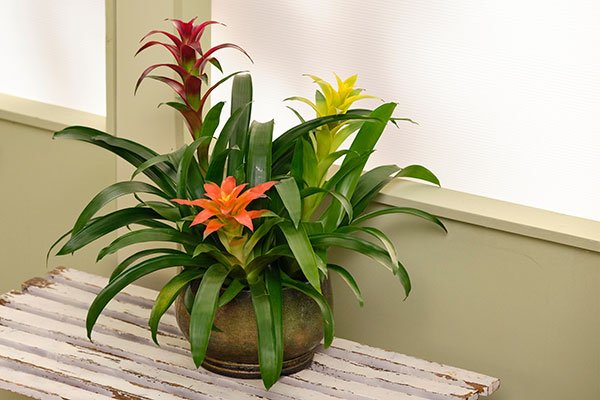 Bromeliads 101In this episode of Life in Bloom- #304- Plants and Flowers for a Healthy Home- I introduce you to Bromeliads and we'll discusses care of the colorful plant. Are you familiar with the family of plants known as Bromeliads? The Pineapple is the Most Familiar Bromelaid – and the only bromeliad that is commercially cultivated for food- there are other bromeliads that are edible…”One of the most memorable attributes of the Bromeliad – is its ability to accumulate water between its leaves- here in the cup in the center of the plant… this is also where the blooms of bromeliad originate… the colorful leaves are NOT actually the bloom- but rather used to attract the attention of pollinators, insects, amphibians, or other invertebrates – that might visit, or take up residence inside the cup. Bromeliads are native to the Americas- but most prolific in South America- specifically the Andean Highlands. One single variety of bromeliad is native to Africa.
Bromeliads 101In this episode of Life in Bloom- #304- Plants and Flowers for a Healthy Home- I introduce you to Bromeliads and we'll discusses care of the colorful plant. Are you familiar with the family of plants known as Bromeliads? The Pineapple is the Most Familiar Bromelaid – and the only bromeliad that is commercially cultivated for food- there are other bromeliads that are edible…”One of the most memorable attributes of the Bromeliad – is its ability to accumulate water between its leaves- here in the cup in the center of the plant… this is also where the blooms of bromeliad originate… the colorful leaves are NOT actually the bloom- but rather used to attract the attention of pollinators, insects, amphibians, or other invertebrates – that might visit, or take up residence inside the cup. Bromeliads are native to the Americas- but most prolific in South America- specifically the Andean Highlands. One single variety of bromeliad is native to Africa.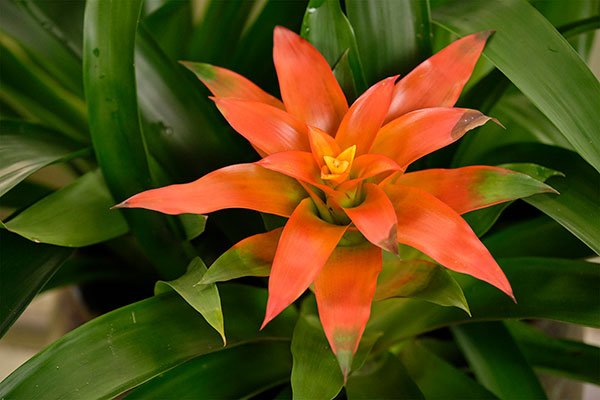 Bromeliads can range in size – from the Largest- Puma Raimondi- that is 3-4 Meters tall- to the smallest- Spanish Moss… how about that… It’s not moss at all- but a form of Bromeliad. Bromeliads are easy to grow- and the Splash of Color and unique texture and shape – add a bit of tropical island to any location. Bromeliad are native to the canopy – in tropical rain forests… so they require Bright In-direct light!Water- is added to the cup- and ideally- you should empty the cup weekly and refill with fresh water- this reduces the build up of bacteria- or the potential of aquatic eggs or insect larvae. A Bromeliad is a wonderful addition- to your home, office or even outdoor living spaces- and will provide years of enjoyment!
Bromeliads can range in size – from the Largest- Puma Raimondi- that is 3-4 Meters tall- to the smallest- Spanish Moss… how about that… It’s not moss at all- but a form of Bromeliad. Bromeliads are easy to grow- and the Splash of Color and unique texture and shape – add a bit of tropical island to any location. Bromeliad are native to the canopy – in tropical rain forests… so they require Bright In-direct light!Water- is added to the cup- and ideally- you should empty the cup weekly and refill with fresh water- this reduces the build up of bacteria- or the potential of aquatic eggs or insect larvae. A Bromeliad is a wonderful addition- to your home, office or even outdoor living spaces- and will provide years of enjoyment!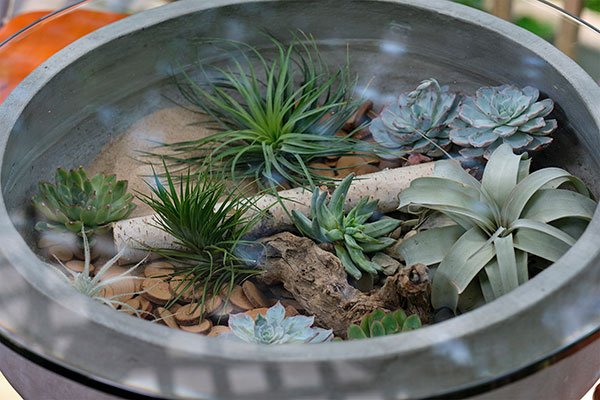 Glass Top Table Garden This is a fun table that can serve as a container as well - let me show you how it works… in this fun segment- I love this table-top (or should I say "Table INSIDE") Idea... that features Decorative Stones, Wood Chips, Driftwood, Sand and of course- Succulents and Tillandsia!Learn more about the Glass Top Table Project here! (follow this link)
Glass Top Table Garden This is a fun table that can serve as a container as well - let me show you how it works… in this fun segment- I love this table-top (or should I say "Table INSIDE") Idea... that features Decorative Stones, Wood Chips, Driftwood, Sand and of course- Succulents and Tillandsia!Learn more about the Glass Top Table Project here! (follow this link)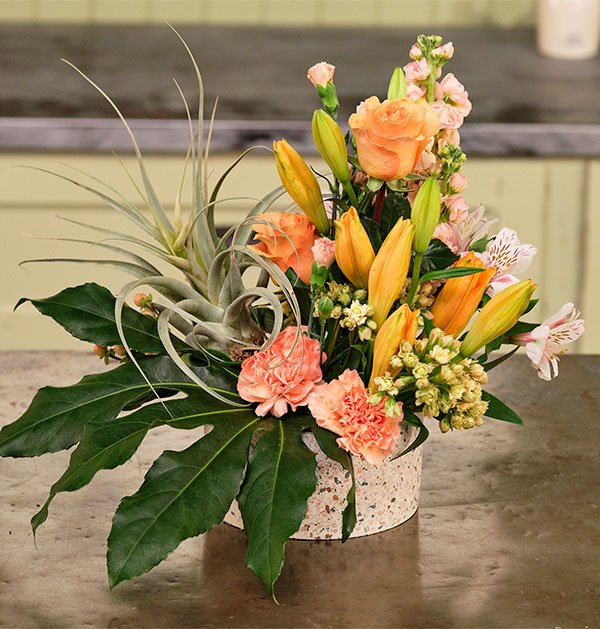 Tillandsia Bouquet In this segment- I create a flower bouquet that includes a Tilandsia ... it becomes a fun focus to the arrangement that can become a keepsake after the flowers have faded! The bouquet that is featured in this project- is the "Cream in Your Coffee" J's Bouquet- that is created by Sunshine Bouquet- and available at Albertsons Companies stores- throughout the USA!
Tillandsia Bouquet In this segment- I create a flower bouquet that includes a Tilandsia ... it becomes a fun focus to the arrangement that can become a keepsake after the flowers have faded! The bouquet that is featured in this project- is the "Cream in Your Coffee" J's Bouquet- that is created by Sunshine Bouquet- and available at Albertsons Companies stores- throughout the USA!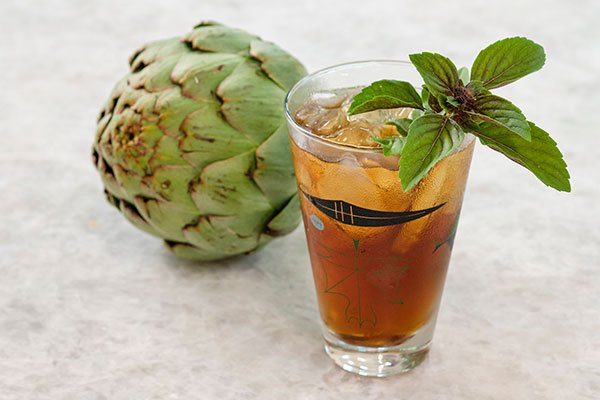 Artichoke Spritzer #FlowerCocktailHour I’m creating a cocktail with an unusual ingredient – a liqueur made from artichokes - and other herbs and plants. It’s dark brown and has a bittersweet flavor. I’ve acquired a taste for bitter flavored liquors… I love it mixed with Lemon Soda… it’s a wonderful aperitif- and it’s simple- and you can garnish it with fresh herbs.Recipe and Instructions:Fill a Highball or Collins glass with crushed ice.Add a Jigger of Cynar liquorTop with Lemon SodaGarnish with Fresh Mint, Oregano, or BasilA little background- about the "Cynar" [tʃiˈnar] - an Italian bitter liqueur. It is made from 13 herbs and plants, predominant amongst which is the artichoke, from which the drink derives its name. Cynar is dark brown in color and has a bittersweet flavor. As I get older- I am more drawn to Bitter Liqueurs - rather than the sweet... So I do love this one!Here's a few more Cynar Cocktail ideas - to share!https://www.supercall.com/entertaining/best-cynar-cocktails
Artichoke Spritzer #FlowerCocktailHour I’m creating a cocktail with an unusual ingredient – a liqueur made from artichokes - and other herbs and plants. It’s dark brown and has a bittersweet flavor. I’ve acquired a taste for bitter flavored liquors… I love it mixed with Lemon Soda… it’s a wonderful aperitif- and it’s simple- and you can garnish it with fresh herbs.Recipe and Instructions:Fill a Highball or Collins glass with crushed ice.Add a Jigger of Cynar liquorTop with Lemon SodaGarnish with Fresh Mint, Oregano, or BasilA little background- about the "Cynar" [tʃiˈnar] - an Italian bitter liqueur. It is made from 13 herbs and plants, predominant amongst which is the artichoke, from which the drink derives its name. Cynar is dark brown in color and has a bittersweet flavor. As I get older- I am more drawn to Bitter Liqueurs - rather than the sweet... So I do love this one!Here's a few more Cynar Cocktail ideas - to share!https://www.supercall.com/entertaining/best-cynar-cocktails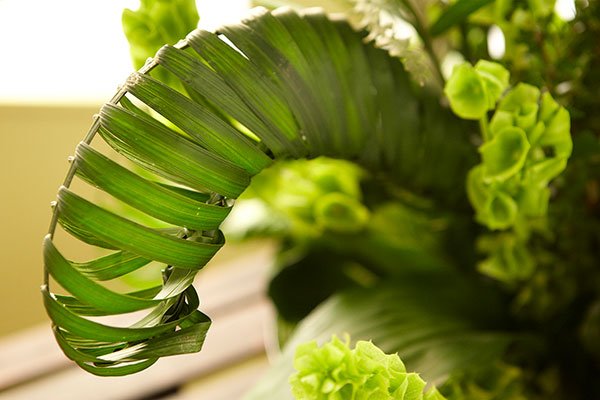 Flower Craft: Weaving Palms Green Plants along with Green Flowers can make for an interesting arrangement – with different shapes and textures. Many years ago, I learned how to weave palm leaves into a Nautilus Shell form- and this is a perfect opportunity to share that craft- Let me show you how to do it and then we’ll add these woven foliage accents to a lovely arrangement that Includes green flowers.
Flower Craft: Weaving Palms Green Plants along with Green Flowers can make for an interesting arrangement – with different shapes and textures. Many years ago, I learned how to weave palm leaves into a Nautilus Shell form- and this is a perfect opportunity to share that craft- Let me show you how to do it and then we’ll add these woven foliage accents to a lovely arrangement that Includes green flowers. Here's a link to another Video I have about creating a Nautilus Shell... Learn more Here!Thanks for joining me today on our journey through the world of plants, learning about their attributes, and creative ways to combine them with flowers. I know plants improve my home, hopefully you’ll invite them into your home, too. For Life In Bloom, I’m J Schwanke.
Here's a link to another Video I have about creating a Nautilus Shell... Learn more Here!Thanks for joining me today on our journey through the world of plants, learning about their attributes, and creative ways to combine them with flowers. I know plants improve my home, hopefully you’ll invite them into your home, too. For Life In Bloom, I’m J Schwanke.

